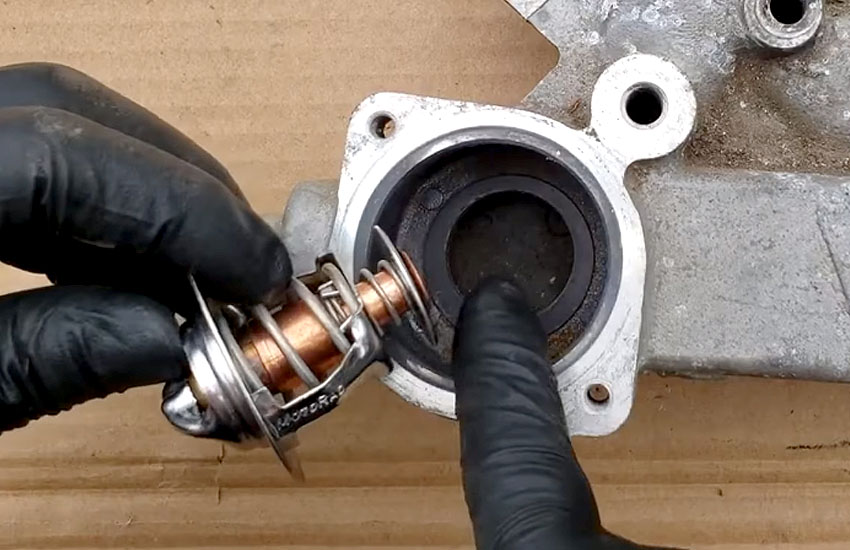Have you ever wondered how your car keeps its engine from getting too hot or too cold? Well, that’s where the thermostat comes in! Imagine the thermostat as the boss of your car’s temperature control system. Its job is to make sure the engine stays at just the right temperature for it to work smoothly.
But sometimes, like any boss, the thermostat can start acting up. When that happens, it can cause all sorts of problems for your car, like overheating or poor performance. That’s why it’s essential to keep an eye on it and make sure it’s working correctly.
Luckily, testing your car’s thermostat doesn’t have to be a big, scary job. In this guide, we’ll show you how you can check if your thermostat is doing its job properly without even taking it out of your car. Let’s get started!

Signs of a Faulty Thermostat
When something goes wrong with your car’s thermostat, it can cause a lot of trouble. Here are some signs that your thermostat might not be working properly:
Engine Overheating
Sometimes, if the thermostat gets stuck closed, it can stop the coolant from flowing through the engine. Without enough coolant, the engine can get too hot and start overheating. If you notice your temperature gauge climbing into the red zone or steam coming from under the hood, it could be a sign of a faulty thermostat.
Engine Running Colder than Usual
On the flip side, if the thermostat gets stuck open, it can let too much coolant flow through the engine, causing it to run cooler than it should. This can lead to poor fuel efficiency, reduced engine performance, and increased emissions. If you notice that your engine takes a long time to warm up or never seems to reach its normal operating temperature, it could indicate a problem with the thermostat.
Fluctuating Temperature Gauge
A malfunctioning thermostat may cause the temperature gauge on your dashboard to fluctuate erratically. You might notice the gauge bouncing between hot and cold or moving up and down rapidly while driving. This inconsistency in temperature readings could indicate a problem with the thermostat’s ability to regulate coolant flow.
Poor Heater Performance
Since the thermostat helps regulate the engine’s temperature, a faulty one can also affect the performance of your car’s heater. If you’re experiencing weak or inconsistent heat from your vents, especially during cold weather, it could be due to a malfunctioning thermostat restricting coolant flow.
Keeping an eye out for these signs can help you catch thermostat issues early and prevent further damage to your car’s engine. If you notice any of these symptoms, it’s essential to have your thermostat checked and replaced if necessary by a qualified mechanic.
Tools and Materials Needed
To test your car’s thermostat without removing it, you’ll need a few basic tools and materials:
Safety Gloves
When working with your car’s cooling system, it’s essential to protect your hands from burns and cuts. Invest in a pair of sturdy safety gloves to keep your hands safe from hot engine components and sharp edges.
Safety Goggles
Coolant can be harmful if it comes into contact with your eyes. Wear safety goggles to shield your eyes from splashes or spills while working on your car’s cooling system.
Coolant Tester or Multimeter
To test your car’s thermostat without removing it, you’ll need either a coolant tester or a multimeter. A coolant tester allows you to check the pressure of the cooling system, while a multimeter helps you measure the thermostat’s resistance.
Owner’s Manual (Optional but Helpful)
While not necessary, having your car’s owner’s manual on hand can provide valuable information about your vehicle’s cooling system, including the location of the thermostat and specific testing procedures recommended by the manufacturer.
Step-by-Step Guide to Testing the Thermostat
Testing your car’s thermostat without removing it is simpler than you might think. Follow these easy steps to ensure your engine’s temperature stays just right:
Park the Car and Let the Engine Cool Down
Before starting any work under the hood, make sure your car is parked on a level surface. Give the engine plenty of time to cool down to avoid burns from hot components.
Locate the Thermostat Housing
The thermostat is usually located between the engine and the radiator. Refer to your car’s owner’s manual if you’re unsure where to find it. Once located, identify the thermostat housing, which is typically attached to the engine and connected to the upper radiator hose.
Test the Thermostat Using a Coolant Tester
- Remove the Radiator or Reservoir Cap: Be cautious as the coolant system might still be pressurized. Use a rag or glove to protect your hand while carefully loosening the cap.
- Insert the Coolant Tester into the Coolant: Follow the manufacturer’s instructions for your specific coolant tester. Typically, you’ll insert the tester into the coolant reservoir or radiator opening.
- Pump the Tester and Observe the Pressure Reading: Pump the tester to increase pressure within the cooling system. Keep an eye on the pressure gauge and compare the reading to the specifications provided in your owner’s manual. If the pressure does not reach the specified range, it could indicate a faulty thermostat.
Test the Thermostat Using a Multimeter (if Applicable)
- Set the Multimeter to the Resistance or Ohms Setting: Ensure the multimeter is set to measure electrical resistance, often denoted by the symbol Ω or “Ohms.”
- Remove the Thermostat from the Housing: Carefully detach the thermostat from its housing. Refer to your owner’s manual for guidance if needed.
- Connect the Multimeter Leads to the Thermostat Terminals: Touch one multimeter leading to each of the thermostat’s terminals. The multimeter should display a resistance reading.
- Check the Resistance Reading Against the Specified Range: Consult your owner’s manual for the recommended resistance range. If the resistance reading falls outside of this range, it suggests a malfunctioning thermostat.
Interpret the Results and Determine the Next Steps:
After completing both tests, carefully interpret the results. If either test indicates a faulty thermostat, it’s essential to replace it promptly to prevent engine damage and maintain optimal performance.
By following these straightforward steps, you can confidently test your car’s thermostat without the need for removal, ensuring your engine stays cool and runs smoothly on the road ahead.
Additional Tips and Precautions
Always Follow Safety Protocols
Ensure your safety by wearing appropriate protective gear, such as safety gloves and goggles, especially when dealing with hot engine components and coolant.
Use Caution When Handling Coolant
Coolant can be harmful if it comes into contact with your skin or eyes. Avoid direct contact and handle it carefully to prevent burns and irritation. Additionally, be mindful of the environment and dispose of coolant properly according to local regulations.
Consult the Owner’s Manual
Refer to your car’s owner’s manual for specific instructions and specifications related to your vehicle’s thermostat and cooling system. Following manufacturer guidelines can help ensure accurate testing and prevent damage to your vehicle.
Seek Professional Assistance if Unsure
If you’re unsure about any aspect of testing your car’s thermostat or if you encounter unexpected issues, don’t hesitate to seek help from a qualified mechanic. They have the expertise and tools necessary to diagnose and address any problems effectively.
Regular Maintenance is Key
To prevent thermostat issues and other cooling system problems, adhere to regular maintenance schedules recommended by your vehicle manufacturer. This includes routine checks of coolant levels, hoses, and belts, as well as timely replacement of worn-out components.
By following these additional tips and precautions, you can ensure a safe and successful thermostat test while maintaining the overall health and performance of your vehicle’s cooling system.
Final Words
I hope this guide has provided you with the confidence and knowledge needed to test your car’s thermostat without the hassle of removal. By following these simple steps and precautions, you can diagnose potential issues early, ensuring your engine stays at the right temperature for optimal performance.
Remember to prioritize safety, consult your owner’s manual, and seek professional assistance if necessary. With regular maintenance and timely thermostat replacement, if needed, you can keep your car running smoothly and enjoy worry-free driving experiences for miles to come.


